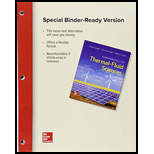
The thickness of the insulation that needed to be used.
The time taken for the insulation to pay for itself from the energy it saves.
Explanation of Solution
Given:
The height of the side surface of the cubic industrial surface
The outer surface temperature of the section
The temperature of the furnace room including the surface
The effectiveness of the outer surface of furnace
The thermal conductivity of the glass wool insulation
The effectiveness of reflective sheet
The reduction in heat loss
The efficiency of the furnace
The price of natural gas
The continuous operation time of furnace
The cost of the installation of insulation
Calculation:
Calculate the film temperature
Refer Table A-22 “Properties of air at 1 atm pressure”.
Obtain the following values of different properties corresponding film temperature
Calculate the volume expansion coefficient
Calculate the characteristics length
Calculate the Rayleigh number
Calculate the Nusselt number
Calculate the surface area of heat transfer
Calculate the heat transfer coefficient of convection
Calculate the rate of heat transfer
Calculate the rate of heat transfer after insulation
Calculate the rate of heat loss after insulation
Calculate the energy saved by installing the insulation
Calculate the total money saved
Means the money saved due to insulation in a year is
Calculate the time taken by the insulation to pay for the cost
Thus, the time taken for the insulation to pay for itself from the energy it saves is
Insulation will reduce the temperature of the surface which reduce the Rayleigh number, Nusselt number, hence for the convection coefficient the temperature of the surface is consider as
Calculate the film temperature
Refer Table A-22 “Properties of air at 1 atm pressure”.
Obtain the following values of different properties corresponding film temperature
Calculate the volume expansion coefficient
Calculate the Rayleigh number
Calculate the Nusselt number
Calculate the surface area of heat transfer
Calculate the heat transfer coefficient of convection
Calculate the rate of heat transfer
The heat loss from the insulation by radiation and convection is equal to heat conduction through insulation.
Calculate the rate of heat transfer through insulation
By use of trial and error method the surface temperature of insulation obtained is
Thus, the time taken for the insulation to pay for itself from the energy it saves is
Want to see more full solutions like this?
Chapter 20 Solutions
Loose Leaf For Fundamentals Of Thermal-fluid Sciences Format: Looseleaf
 Elements Of ElectromagneticsMechanical EngineeringISBN:9780190698614Author:Sadiku, Matthew N. O.Publisher:Oxford University Press
Elements Of ElectromagneticsMechanical EngineeringISBN:9780190698614Author:Sadiku, Matthew N. O.Publisher:Oxford University Press Mechanics of Materials (10th Edition)Mechanical EngineeringISBN:9780134319650Author:Russell C. HibbelerPublisher:PEARSON
Mechanics of Materials (10th Edition)Mechanical EngineeringISBN:9780134319650Author:Russell C. HibbelerPublisher:PEARSON Thermodynamics: An Engineering ApproachMechanical EngineeringISBN:9781259822674Author:Yunus A. Cengel Dr., Michael A. BolesPublisher:McGraw-Hill Education
Thermodynamics: An Engineering ApproachMechanical EngineeringISBN:9781259822674Author:Yunus A. Cengel Dr., Michael A. BolesPublisher:McGraw-Hill Education Control Systems EngineeringMechanical EngineeringISBN:9781118170519Author:Norman S. NisePublisher:WILEY
Control Systems EngineeringMechanical EngineeringISBN:9781118170519Author:Norman S. NisePublisher:WILEY Mechanics of Materials (MindTap Course List)Mechanical EngineeringISBN:9781337093347Author:Barry J. Goodno, James M. GerePublisher:Cengage Learning
Mechanics of Materials (MindTap Course List)Mechanical EngineeringISBN:9781337093347Author:Barry J. Goodno, James M. GerePublisher:Cengage Learning Engineering Mechanics: StaticsMechanical EngineeringISBN:9781118807330Author:James L. Meriam, L. G. Kraige, J. N. BoltonPublisher:WILEY
Engineering Mechanics: StaticsMechanical EngineeringISBN:9781118807330Author:James L. Meriam, L. G. Kraige, J. N. BoltonPublisher:WILEY





